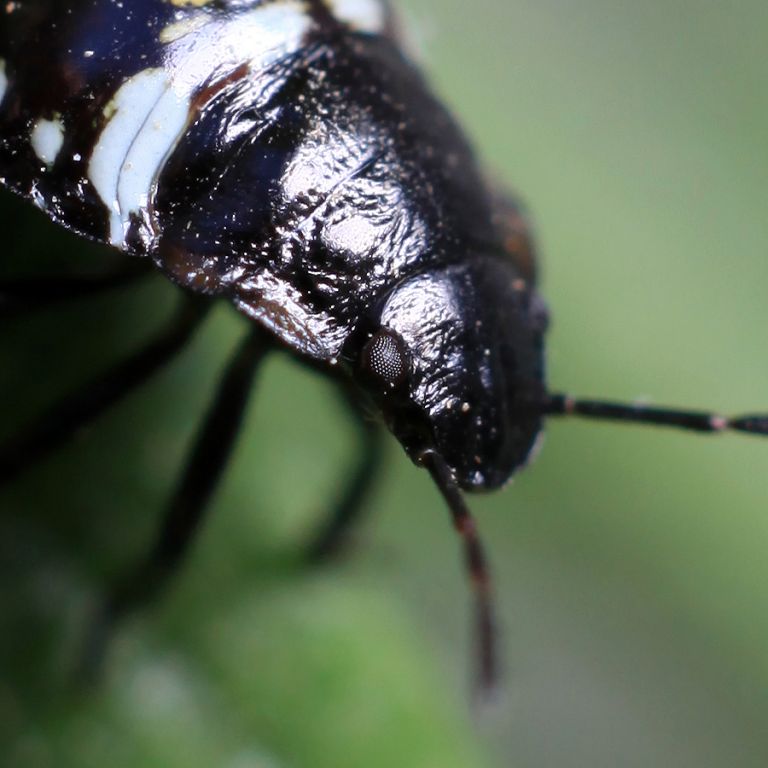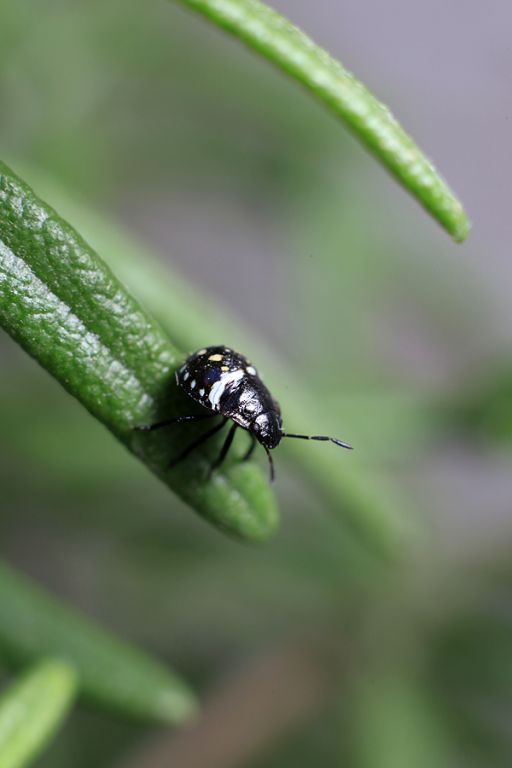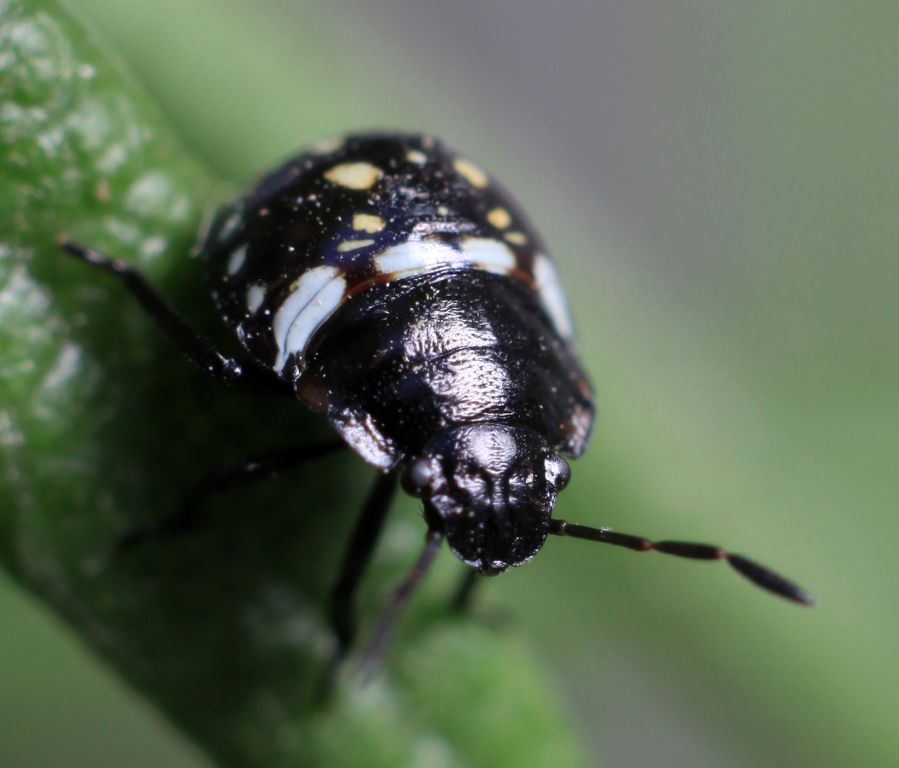| View previous topic :: View next topic |
| Author |
Message |
PaulC


Joined: 23 Dec 2008
Posts: 2318
|
 Posted: Thu Aug 13, 2009 8:03 am Post subject: Micro-Nikkor 55 and tubes on 5D II Posted: Thu Aug 13, 2009 8:03 am Post subject: Micro-Nikkor 55 and tubes on 5D II |
 |
|
PaulC wrote:
I decided to give the Micro-Nikkor-P a go with 56mm of extension tubes (the lens was originally supplied with a fairly long tube) to see what it can manage on a 5D MkII.
The target was a small beetle, about 5mm long, which has been feeding on my rosemary plant.



The top image is a 100% 72dpi crop from the frame, the second one is resized to show the whole insect (about a 50% reduction) and at the bottom is the entire frame, to show how large the subject would be on a 35mm neg.
I was using off-camera diffused flash close to the side of the lens, I tried to introduce a small reflector but the insect kept moving so I doubt if it did anthing, and this was shot at f16, ISO 250 (f11 might have been slightly sharper).
It looks to me like a pretty impressive performance for a 1960s lens (that is still ridiculously cheap - mine cost about $55 plus shipping). If anybody is looking for one, the serial number is important as there are a couple of different designs listed - I have serial number 664xxx.
Here's one more shot from the series:

I estimate the antennae at less than 1/10mm and the compound eye elements, which are just visible at full size, at less than 1/100mm. I'm not sure how to convert that into line pairs per mm.
_________________
View or buy my photos at:
http://shutterstock.com/g/paulcowan |
|
| Back to top |
|
 |
Jesito


Joined: 24 Aug 2007
Posts: 5745
Location: Olivella, Catalonia, (Spain)
Expire: 2015-01-07
|
 Posted: Thu Aug 13, 2009 9:24 am Post subject: Posted: Thu Aug 13, 2009 9:24 am Post subject: |
 |
|
Jesito wrote:
What kind of flash are you using?
Maybe you would need some kind of diffuser to make the light shot softer and avoid the white reflections...
Regards,
Jes.
_________________
Jesito, Moderator 
Jesito's backsack:
Zooms Sigma 70-300, Tamron 35-135 and 70-210 short, 70-210 long, 28-70 CF Macro, 35-70, 35-80, Vivitar 70-210 KA, Tamron 70-250.
Fixed Industar-50, , Tamron 24mm, Tamron 135mm, Sands Hunter 135mm, Pancolar 50mm, Volna-3, many Exakta lenses
DSLR SIGMA SD9 & SD14, EOS 5D, Sony A700 and NEXF3, Oly E-330, E-400, E-450, E-1
TLR/6x6/645 YashicaMat, Petri 6x45, Nettar, Franka Solida, Brilliant
SLR Minolta X300, Fuji STX II, Praktica VLC3, Pentax P30t, EXA500, EXA 1A, Spotmatic(2), Chinon CM-4S, Ricoh, Contax, Konica TC-X , Minolta 5000, 7000i, 3Sxi, EOS 500 and CX
Rangefinders Chinon 35EE, Konica C35 auto, Canonet 28, Yashica Lynx, FED-2, Yashica electro 35, Argus C3 & C4, Regula Cita III, Voigtlander Vitoret (many), Welta Welti-I, Kodak Signette 35, Zorki-4, Bessa-R & L, Minolta Weathermatic, olympus XA2
Compact Film Konica C35V, Voigtlander Vitorets, Canon Prima Super 105, Olympus XA2 and XA3
Compact Digital Olympus C-5050, Aiptek Slim 3000, Canon Powershot A540, Nikon 5200, SIGMA DP1s, Polaroid X530, IXUS55, Kodak 6490, Powershot G9 and G10
CSCCanon EOS-M, Samsung NX100 and NX210, Lumix G5, NEX-F3 |
|
| Back to top |
|
 |
PaulC


Joined: 23 Dec 2008
Posts: 2318
|
 Posted: Thu Aug 13, 2009 9:32 am Post subject: Posted: Thu Aug 13, 2009 9:32 am Post subject: |
 |
|
PaulC wrote:
I only have a Vivitar 285 with me, which I used with a plastic diffuser in front of it, but it's not ideal. Avoiding reflections off an insect's carapace is a considerable skill which I haven't managed to master yet.
Anyway, my point was not to promote these as great photos, it was to show the sort of resolution the micro-Nikkor 55 offers.
_________________
View or buy my photos at:
http://shutterstock.com/g/paulcowan |
|
| Back to top |
|
 |
patrickh


Joined: 23 Aug 2007
Posts: 8551
Location: Oregon
Expire: 2011-11-18
|
 Posted: Thu Aug 13, 2009 6:25 pm Post subject: Posted: Thu Aug 13, 2009 6:25 pm Post subject: |
 |
|
patrickh wrote:
The nikkor micro 55/3,5 is one of the best values in the market. For some reason its price has not reflected its quality, possibly due to age.
patrickh
_________________
DSLR: Nikon D300 Nikon D200 Nex 5N
MF Zooms: Kiron 28-85/3.5, 28-105/3.2, 75-150/3.5, Nikkor 50-135/3.5 AIS // MF Primes: Nikkor 20/4 AI, 24/2 AI, 28/2 AI, 28/2.8 AIS, 28/3.5 AI, 35/1.4 AIS, 35/2 AIS, 35/2.8 PC, 45/2.8 P, 50/1.4 AIS, 50/1.8 AIS, 50/2 AI, 55/2.8 AIS micro, 55/3.5 AI micro, 85/2 AI, 100/2,8 E, 105/1,8 AIS, 105/2,5 AIS, 135/2 AIS, 135/2.8 AIS, 200/4 AI, 200/4 AIS micro, 300/4.5 AI, 300/4.5 AI ED, Arsat 50/1.4, Kiron 28/2, Vivitar 28/2.5, Panagor 135/2.8, Tamron 28/2.5, Tamron 90/2.5 macro, Vivitar 90/2.5 macro (Tokina) Voigtlander 90/3.5 Vivitar 105/2.5 macro (Kiron) Kaleinar 100/2.8 AI Tamron 135/2.5, Vivitar 135/2.8CF, 200/3.5, Tokina 400/5,6
M42: Vivitar 28/2.5, Tamron 28/2.5, Formula5 28/2.8, Mamiya 28/2.8, Pentacon 29/2.8, Flektogon 35/2.4, Flektogon 35/2.8, Takumar 35/3.5, Curtagon 35/4, Takumar 50/1.4, Volna-6 50/2.8 macro, Mamiya 50/1.4, CZJ Pancolar 50/1,8, Oreston 50/1.8, Takumar 50/2, Industar 50/3.5, Sears 55/1.4, Helios 58/2, Jupiter 85/2, Helios 85/1.5, Takumar 105/2.8, Steinheil macro 105/4.5, Tamron 135/2.5, Jupiter 135/4, CZ 135/4, Steinheil Culminar 135/4,5, Jupiter 135/3.5, Takumar 135/3.5, Tair 135/2.8, Pentacon 135/2.8, CZ 135/2.8, Taika 135/3.5, Takumar 150/4, Jupiter 200/4, Takumar 200/4
Exakta: Topcon 100/2.8(M42), 35/2.8, 58/1.8, 135/2.8, 135/2.8 (M42), Kyoei Acall 135/3.5
C/Y: Yashica 28/2.8, 50/1.7, 135/2.8, Zeiss Planar 50/1.4, Distagon 25/2.8
Hexanon: 28/3.5, 35/2.8, 40/1.8, 50/1.7, 52/1.8, 135/3.2, 135/3.5, 35-70/3.5, 200/3.5
P6 : Mir 38 65/3.5, Biometar 80/2.8, Kaleinar 150/2.8, Sonnar 180/2.8
Minolta SR: 28/2.8, 28/3.5, 35/2.8, 45/2, 50/2, 58/1.4, 50/1.7, 135/2.8, 200/3.5
RF: Industar 53/2.8, Jupiter 8 50/2
Enlarg: Rodagon 50/5,6, 80/5,6, 105/5.6, Vario 44-52/4, 150/5.6 180/5.6 El Nikkor 50/2,8,63/2.8,75/4, 80/5,6, 105/5.6, 135/5.6 Schneider 60/5.6, 80/5.6, 80/4S,100/5.6S,105/5.6,135/5.6, 135/5.6S, 150/5.6S, Leica 95/4 |
|
| Back to top |
|
 |
Attila


Joined: 24 Feb 2007
Posts: 57865
Location: Hungary
Expire: 2025-11-18
|
 Posted: Thu Aug 13, 2009 7:14 pm Post subject: Posted: Thu Aug 13, 2009 7:14 pm Post subject: |
 |
|
Attila wrote:
| patrickh wrote: |
The nikkor micro 55/3,5 is one of the best values in the market. For some reason its price has not reflected its quality, possibly due to age.
patrickh |
+1 I think price is low due very common and people like longer macro better due longer working distance. Quality is NR 1 indeed.
_________________
-------------------------------
Items on sale on Ebay
Sony NEX-7 Carl Zeiss Planar 85mm f1.4, Minolta MD 35mm f1.8, Konica 135mm f2.5, Minolta MD 50mm f1.2, Minolta MD 250mm f5.6, Carl Zeiss Sonnar 180mm f2.8
|
|
| Back to top |
|
 |
PaulC


Joined: 23 Dec 2008
Posts: 2318
|
 Posted: Sat Aug 15, 2009 8:28 am Post subject: Posted: Sat Aug 15, 2009 8:28 am Post subject: |
 |
|
PaulC wrote:
| Attila wrote: |
| patrickh wrote: |
The nikkor micro 55/3,5 is one of the best values in the market. For some reason its price has not reflected its quality, possibly due to age.
patrickh |
+1 I think price is low due very common and people like longer macro better due longer working distance. Quality is NR 1 indeed. |
Possibly this is so, but won't a longer working distance give less magnification or require longer tubes, bringing you closer to the subject again? I must try different tubes on different length lenses to see what happens.
In any case, it is absurd for people to overlook this lens which not only offers you superb macro ability (even without a tube it can project an image 50% of the actual size on to the film or sensor - compared with the 10% or so that makers today call "macro") but is also a ridiculously cheap and very sharp standard lens with excellent bokeh and colour rendition.
In the old days "macro" was used to mean projecting the image at full size on to the film and with its original tube the micro-Nikkor 55 was a true macro lens. Today the word has been diluted (by manufacturers?) to mean producing an image that will give 1:1 reproduction after being enlarged to some print size or other, which is a far less useful capability if you want to explore the tiny details of our world.
_________________
View or buy my photos at:
http://shutterstock.com/g/paulcowan |
|
| Back to top |
|
 |
|
|
|
You cannot post new topics in this forum
You cannot reply to topics in this forum
You cannot edit your posts in this forum
You cannot delete your posts in this forum
You cannot vote in polls in this forum
|
